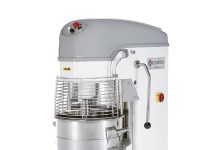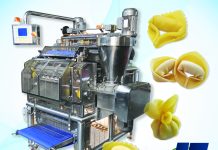In the 1930s when durum wheat started to be grown in central and northern Italy in an effort to make the country self-sufficient, factories in the north began producing pasta, and electric drying tunnels replaced sea and volcanic breezes. Naples little by little decreased of importance in the manufacture of pasta, today the Naples-area is only the sixth-largest producer of pasta in the Italy. Drying is one the most important unit operation in pasta manufacture. The temperature and for how long the pasta is dried are key factors for the quality of cooked pasta. In recent years, the high-temperature (HT) drying technology has been widely applied. The advantages over the low-temperature (LT) drying process are the reduction of drying time and increased plant productivity. Moreover, HT drying improves mechanical properties of pasta, such as breaking strength and surface state. The cooking quality of the product improves, with higher firmness, lower stickiness and bulkiness, and reduced water absorption and cooking loss. The draw back is that HT drying induces the formation of several Maillard reaction products, which, at various extents, results in unwanted effects such as color alterations and depletion of the bio-available lysine. On contrary, low temperatures greatly improve flavor; when in cool environment, in practice, in order to achieve a proper drying it’s necessary to expand time that pasta rests in the tunnel. In order to limit the Maillard reaction is necessary to check the amylase activity of the semolina and the hygro-thermal conditions of the dryers. The analysis of the volatile compounds can give information about the raw material quality and their right way of processing. On this purpose, a continuous online monitoring of the undergoing process allows to identifying precocious markers of subsequent defects. There are a great variety of automatic dryers, in correspondence with the different types of dough that are to be obtained and with the complexity of the treatment that the dough undergo in order to achieve a good degree of drying. It can be obtained either through static cells, or tunnel in which circulates hot air.
Tunnels driers are generally for long pasta
 This dryers are continuous systems consisting of long tunnel which can even reach lengths of 60-70 meters, in them the dough moves in continuous forward motion on rods translating on continuous chains, the hot air circulates counter-current or orthogonally to product, undergoing it to the different phases of drying which are obtained by suitably varying the environmental conditions of the different sections of the tunnel, each separated by closures watertight or without real physical partitions, each area is with it’s own specific climate; in particular are the ventilation flow control and the flow humidity rate control allowing to have different climatically areas where pasta undergo different phases. These phases are : the wrapping, the recover and the final drying. the wrapping phase is when a natural crust on the outside created, while the inner dough, not in direct contact with the hot air of the dryer, is more humid than the pasta more external, the inner moisture transfers then by osmosis to the surface crust softening it again, on this second stage the pasta “recovers” from figurative exposure to the sun. At this stage the drying racks move to a room forty degrees cooler than the first phase of the “ wrapping” with higher humidity that slightly soften the surface. The third phase or “final drying” stage the pasta is subjected to alternating warmer and cooler temperatures to get the drying just right. The pasta rests in tunnel for several hours; as the pasta moisture reduces, it is important that the water particles left are redistributed evenly from core to surface, the pasta moisture reduces gradually to a steady final value not higher than 12.5%
This dryers are continuous systems consisting of long tunnel which can even reach lengths of 60-70 meters, in them the dough moves in continuous forward motion on rods translating on continuous chains, the hot air circulates counter-current or orthogonally to product, undergoing it to the different phases of drying which are obtained by suitably varying the environmental conditions of the different sections of the tunnel, each separated by closures watertight or without real physical partitions, each area is with it’s own specific climate; in particular are the ventilation flow control and the flow humidity rate control allowing to have different climatically areas where pasta undergo different phases. These phases are : the wrapping, the recover and the final drying. the wrapping phase is when a natural crust on the outside created, while the inner dough, not in direct contact with the hot air of the dryer, is more humid than the pasta more external, the inner moisture transfers then by osmosis to the surface crust softening it again, on this second stage the pasta “recovers” from figurative exposure to the sun. At this stage the drying racks move to a room forty degrees cooler than the first phase of the “ wrapping” with higher humidity that slightly soften the surface. The third phase or “final drying” stage the pasta is subjected to alternating warmer and cooler temperatures to get the drying just right. The pasta rests in tunnel for several hours; as the pasta moisture reduces, it is important that the water particles left are redistributed evenly from core to surface, the pasta moisture reduces gradually to a steady final value not higher than 12.5%




